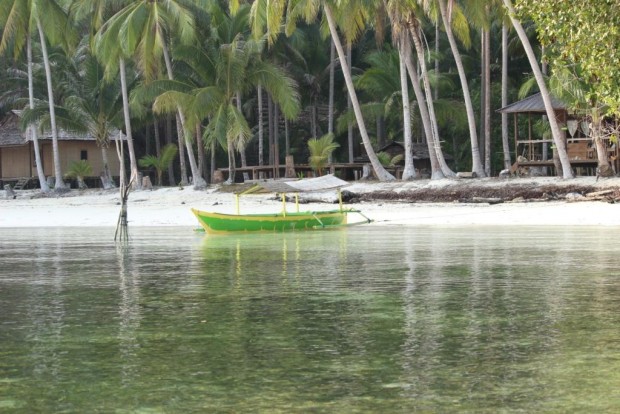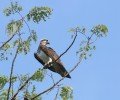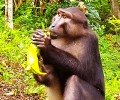Sharing Harvest
“All our pineapples are gone,” I said to Meidy.
“Macaques?”
“Almost certain. Only the tip leaves are left; they messed the whole plants.” The leaves are saw-toothed, inedible to the apes.
“It is OK. They need food.” Oh, la, la, Mom of the macaques defended her ‘children’.
It is fun to see the platoon of the apes hanging, swinging, and jumping on our two huge mango trees. They still leave us mangoes more than we can eat–one tree could produce more than 600 mangoes during the season. But, it is no fun to see my crops and fruits are finished by them.
Almost all vegetables and fruits come from the harbor town of Ampana, 7-hour public boat from our home. Therefore, I had prepared the slope of the east cliff for crops and fruit garden; the seeding bed is on the yard, close to the wells. The slope is very steep, between 45 and 60 degree inclination (see the center background on the photo) and rocky. The top soil layer is between zero to 15 cm, too thin. With a machete, digging stick and spade, I worked for two months to clear the scrub and bush, landscape terracerings (stepped soil beds), and dig five big holes (1 meter deep) for rain water storage. Not bad for the hands usually hold stethoscope and computer keyboard. My palms are callous; my right arm is bigger than the left one and its veins are prominent and touchable; and I have ‘lumps’ on my upper arms when I bend my elbows–I often show them to Meidy and she always says ‘T-O-P’. Dark skin and skinny, but muscular, I really look like more a local farmer than a doctor.
While waiting for the rain falls–there has not been any rain for five months–I started spreading chilly seeds and some other plants on the seeding beds and watered them with buckets of well water twice a day. Within two weeks, I could see many young plant growing. It was so wonderful; within two months, we would not need to buy chilly, mints, and some other vegetables.
Two weeks later, almost all the saplings were disappeared. Ker and Kongkorongok, our chicken and roaster, had messed the beds. Thus, another work has to be done: fencing the seeding beds. It was not so hard to cut the palm frond for the fence, but it was a time consuming task because I needed more than 100 sticks.
I have been thinking about the method to keep some of the crops and fruit harvest from the raid of macaques, babyroussa (pigdeer), bats, and other wildlife. Fencing is not the option: the farm is too large and the animals can break them easily; guarding is impossible: who likes to stay overnight in the farm, feeding mosquitoes and gnats? I wish someone could help me to find an ecologically friendly solution on the harvest distribution among multiple species.





